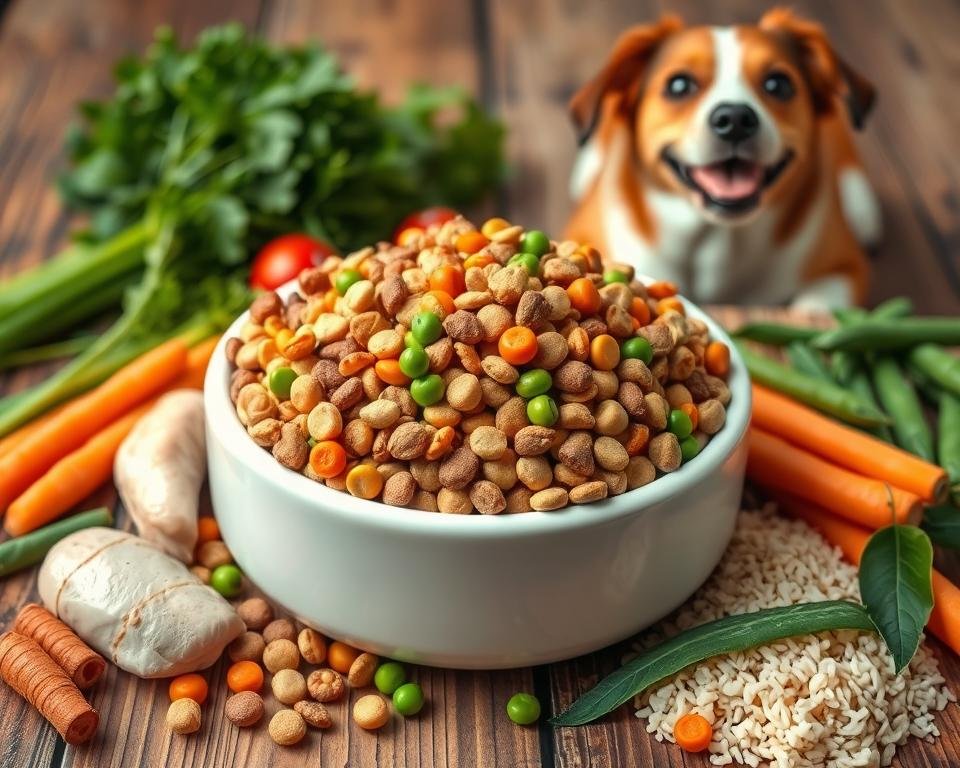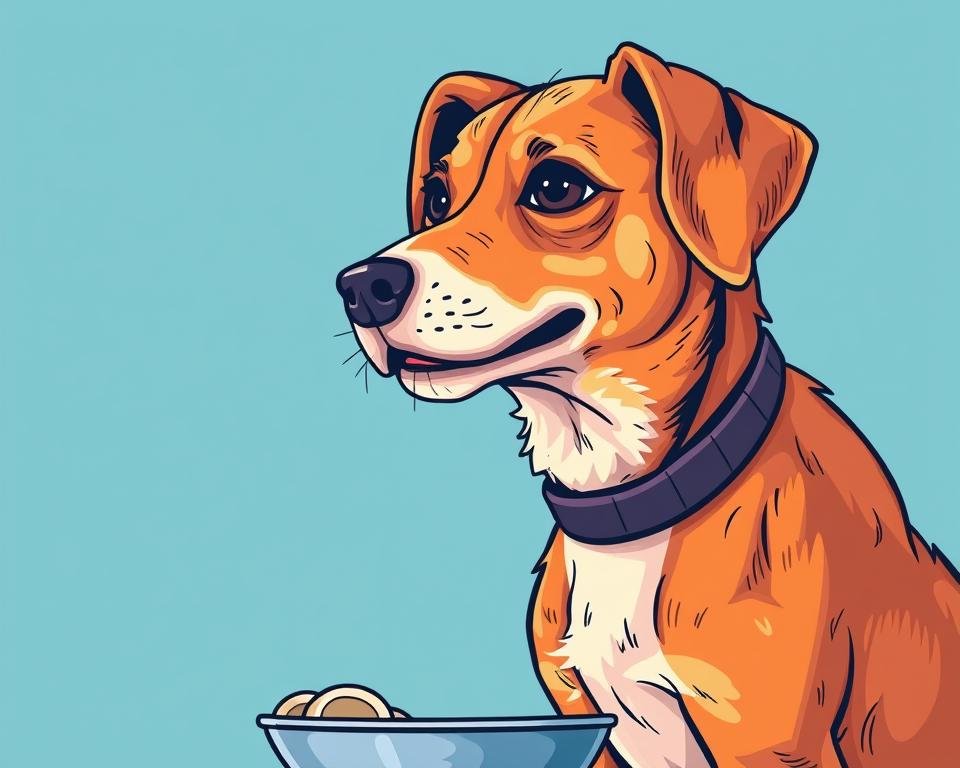It’s vital to give your dog a balanced diet for their health. A 40-pound dog that’s moderately active needs about 1,000 kilocalories (kcal) daily. This guide will help you understand how to feed your dog 1000 calories a day. We’ll cover daily caloric needs, nutrient requirements, portion control, and how to measure food.
Feeding your dog the right food is key, whether it’s commercial or homemade. It’s important to give them high-quality, animal-based nutrients for their health. By following this guide, you can ensure your dog gets a nutritious diet that supports their well-being.
Understanding Daily Caloric Needs for Dogs
It’s important to give your dog the right amount of calories for their health. A dog’s caloric needs change based on their age, metabolism, and how active they are. To figure out how many calories your dog needs, you need to know about Resting Energy Requirements (RER) and Daily Energy Requirements (DER).
Factors Affecting Caloric Requirements
Many things affect a dog’s caloric needs, like their breed, age, body type, if they’ve been spayed or neutered, and how active they are. For example, older dogs need fewer calories because they lose muscle. Dogs that are very active or pregnant/nursing need more. Dogs with more muscle also need more calories.
Calculating Resting Energy Requirements (RER)
To find out your dog’s daily calorie needs, start with their Resting Energy Requirements (RER). This involves raising your dog’s weight in kilograms to the power of 0.75, then multiplying by 70. This number shows how many calories your dog needs to stay at their current weight while resting.
Determining Daily Energy Requirements (DER)
After finding the RER, you can figure out the Daily Energy Requirements (DER) by multiplying the RER by an activity factor. This factor can be between 1.6 for a low-activity dog and 3.0 for a very active one. The DER gives you a starting point for dog calorie needs and how much food your dog should eat.
“Consulting a veterinarian is recommended, even more so for dogs with health conditions or special dietary needs, to make sure they get the right calories for their health.”
By knowing what affects a dog’s calorie needs and using RER and DER, you can help your dog get the right amount of calories. This supports their overall health and wellbeing.
1000 Calories a Day Dog Food Guidelines
Creating a dog food plan for 1000 calories a day is important. You need to balance protein, fats, and carbs for your dog’s health and energy. This balance is key.
A 1000-calorie diet should have 60-85% meat. This includes muscle and organ meats for high-quality protein. Add 10-20% veggies and seeds for vitamins, minerals, and fiber. The last 5-10% can be healthy fats like fish oil or coconut oil.
This means about 19-20 ounces (538-567 grams) of food a day. But, the exact amount depends on the food’s density and your dog’s needs. Always check with your vet to find the right portions for your dog’s 1000 calorie dog meal plan.

“Proper portion control and a balanced dog diet are key for your pup’s health and happiness.”
The dog food guide is just a starting point. You might need to adjust based on your dog’s activity, age, and health. Watch your dog’s condition and energy to fine-tune the 1000 calorie dog meal plan. This ensures they stay healthy and happy.
Essential Nutrients and Meal Components
It’s vital to give your dog a balanced diet for their health. A balanced dog food should have the right mix of nutrients.
Protein Requirements
Protein is key in a dog’s diet. Choose lean meats like chicken, turkey, or lean beef. For puppies, pick meats that are 87-93% lean. Adult dogs can have up to 85-93% lean meat.
Fat Content Guidelines
Fats are important for energy and vitamin absorption. Make sure to balance omega-3 and omega-6 fatty acids. Adding 1-2 grams of fish oil per 1000 kcal is beneficial.
Carbohydrates and Fiber Needs
Carbs and fiber should be 10-20% of your dog’s diet. Use veggies and seeds like spinach and carrots. They add nutrients and support health.
“Proper nutrition is the foundation of a dog’s health and wellbeing. By understanding their essential nutrient needs, you can create a diet that supports their optimal growth and development.”
Portion Control and Feeding Schedule
Keeping a regular dog feeding schedule and portion control is key for your dog’s health. Dogs do well with routine. A diet that fits their needs helps them stay at a healthy weight and get the right nutrients.
Adult dogs can eat once or more times a day. If you give them more meals, split their daily calories by the number of meals. This ensures they get the right amount of food. Keeping feeding times and amounts the same is important for their health.
To figure out the right food amounts, think about your dog’s size, how active they are, and their specific needs. Watch their weight and body shape closely. Adjust their food portions as needed to keep them at a healthy weight. Treats should not make up more than 10% of their daily calories to prevent weight gain.
“Portion control and a consistent feeding schedule are cornerstones of a healthy and happy dog. By tailoring your approach to your furry friend’s unique needs, you can help them thrive and maintain a healthy weight for years to come.”
Having a set dog feeding schedule and controlling portions greatly benefits your dog’s health. By understanding your dog’s needs and adjusting their dog meal frequency, you ensure they get the right food. This helps them live a long, active, and happy life.
Measuring and Tracking Food Intake
Keeping an eye on your dog’s calorie intake is key. Use kitchen scales to measure food portions accurately. This ensures you give the right amount of calories for your dog’s needs.
Also, read pet food labels to know the calories per serving. This info is vital for watching your dog’s daily calorie intake.
Next, track your dog’s calorie intake, including treats. This lets you adjust their diet as needed. For a 1000-calorie diet, aim for about 19-20 ounces (538-567 grams) of food daily. Adjust this based on the food’s caloric density.
Regularly check your dog’s body condition and weight. This is important to make sure their diet is working. Adjust their diet with your vet’s help to keep them at the right weight and healthy.
By measuring, tracking, and adjusting your dog’s calorie intake, they can do well on a 1000-calorie-a-day diet.



